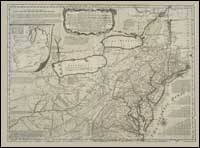 |
 |
 |
|
|||
 |
 |
|
|
|||
|
|
||||||
| |
|
|
|
|
||
|
|
|
|
|
|
|
|
|
| Middle Atlantic Region & the Wider World
The Middle Atlantic region is defined as that area east of the Appalachian Mountains from New York south to Virginia, incorporating important waterways and urban areas along the way. This digital collection includes maps of the entire region, as well as maps of its political areas and major geographic features, including the critical river links to the interior. The Middle Atlantic region was the commercial and, along with Boston, the political heart of first the colonies and later the new nation. The capitals of the new democratic government - New York City, Philadelphia, and ultimately Washington, D.C. - were all located in this region. Its coastal location facing Europe and its mighty rivers, the Hudson, the Delaware, and the Potomac, offering gateways to the interior of the continent, provided the foundation for the developing economic engine based on trade and shipping. Pre-1850 maps of North America often show information about the Middle Atlantic region in relation to the larger nation, the continent, and the world. These coastal regions, even after the formation of the United States, continued to look outward toward Europe for their identity, and for trade and support. Maps from the 17th and 18th centuries focused on the trade routes and geographic information linking the region to its trading partners in Europe and the West Indies. Although the depiction of the Middle Atlantic
coastline was relatively accurate on early maps, the interior, Appalachia
and beyond, remained clearly inaccurate for decades. Following river
valleys and Indian trails, explorers, settlers, and exploiters of
natural resources broke through the Appalachian barrier early in
the 18th century. But these continental interiors were only sketchily
reflected on maps prior to 1850. |
||
